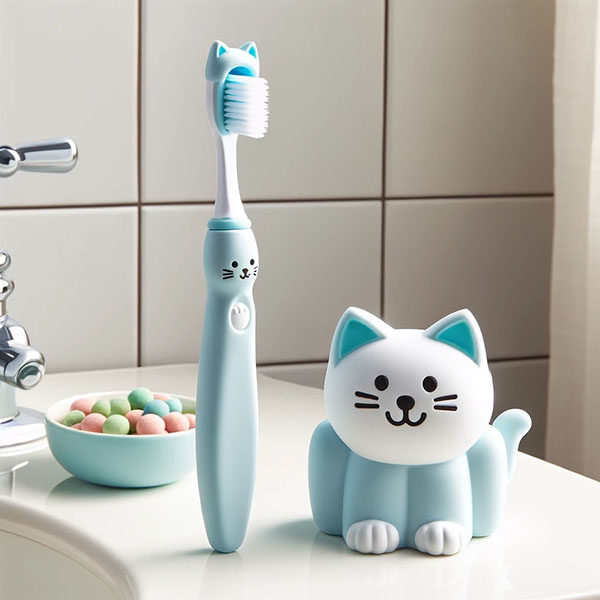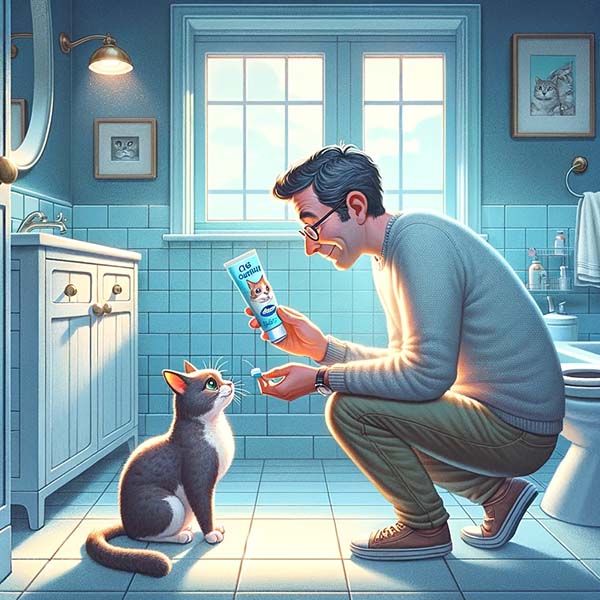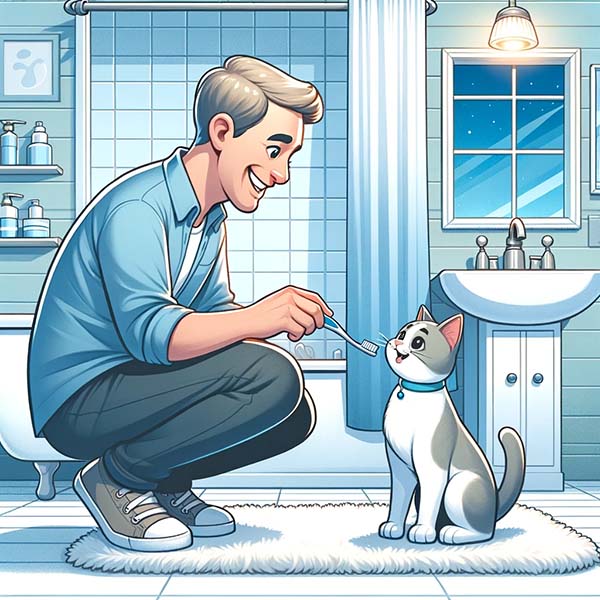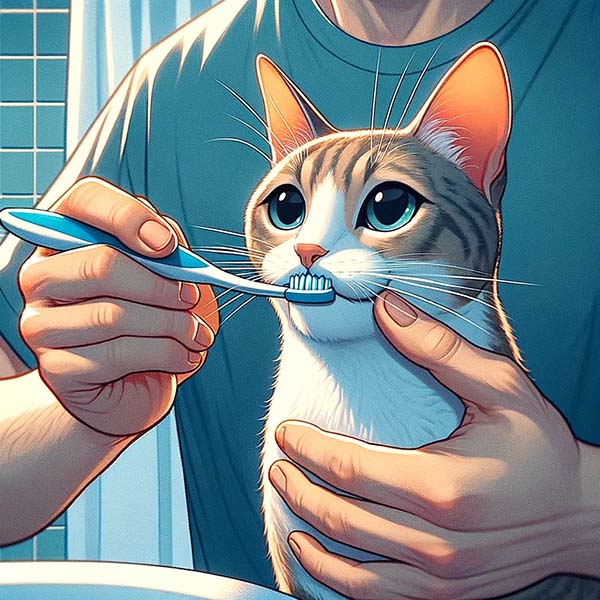With their soft fur and captivating eyes, cats have a knack for making us feel cherished. But there's one aspect of cat ownership that often gets overlooked amidst the cuddles and playtime: dental care! When it comes to your cat's well-being, dental care plays a role that goes beyond just fresh breath. Maintaining healthy teeth and gums is crucial for their overall health and happiness. Yet, many pet parents overlook this crucial aspect of pet care.
If you've ever been greeted by the unmistakable aroma of "fish breath" when your cat leans in for a nuzzle, you know the importance of maintaining oral hygiene! Like us, cats need a little help in the teeth-cleaning department to ensure they have the freshest breath possible. The American Veterinary Dental Society reports that over 80 percent of dogs and 70 percent of cats encounter tooth and gum disease by age three. Periodontal disease is the prevailing dental condition affecting dogs and cats alike.
In this guide, we will dive deep into cat dental care and how to maintain your cat's oral health. We'll show you how to transform your feline friend's dental hygiene routine into an adventure that benefits both of you. Remember that a daily dental care routine, annual dental checkup, and a well-balanced diet are the keys to ensuring your cat's enduring happiness and overall health.
How To Clean Your Cat's Teeth
Ensuring the dental health of your cat is crucial for their overall well-being. Untreated dental issues in cats can result in pain, discomfort, and potentially more severe health problems. Fortunately, you can manage your cat's dental hygiene at home with the appropriate approach and patience. Here is how to brush your cat's teeth at home:
Tools Needed For Brushing Your Cat's Teeth
Toothbrush - Use a toothbrush specially designed for cats and small dogs. A finger brush works just as well and can frequently be found in the toddler section of the toothbrush aisle in a supermarket.
Toothpaste - Avoid using human toothpaste! Opt for cat toothpaste or dental gel, both readily available at most pet supply stores.
Treats - As you start your cat's daily dental routine, it will be necessary to have treats or rewards on hand for positive reinforcement.
Directions For Cat Teeth Cleaning
Step 1: Gather Your Supplies

To get started with caring for your cat's oral health, ensure you have all the necessary tools at your fingertips. These tools are listed above - cat toothbrush, cat toothpaste, and cat treats! You'll also need a quiet, comfortable space for the procedure. Having everything ready beforehand minimizes any disruptions during the process.
Step 2: Choose The Right Time
Timing plays a crucial role in the success of your kitty's oral health routine. Cats are creatures of habit and often have preferred moments of relaxation. Choose a time when your cat is calm, like after a meal or a play session. Avoid attempting teeth and gum massage when your cat is agitated or stressed, as it can make the process more challenging. Choose a time that occurs on a daily basis (again, after a meal is best). Our habit-loving feline friends are more apt to cooperate with a regular tooth brushing routine if it occurs at the same time each day!
Step 3: Introduce Toothpaste

Cat toothpaste and dental gel typically come in flavors that cats find appealing, such as chicken or seafood. Start by allowing your cat to taste a small amount of the toothpaste. This initial step helps your cat become accustomed to the flavor and texture, making them more willing to cooperate during the brushing process.
Step 4: Get Your Cat Comfortable
Before starting the brushing, create a comfortable environment for your cat. Gently pet them and speak in soothing tones to help keep them at ease. This helps establish a sense of trust and relaxation, making your cat more receptive to brushing its teeth.
Step 5: Introduce The Toothbrush

Choose a toothbrush that suits your cat's comfort level. Some cats may prefer a traditional cat toothbrush, while others might be more at ease with a finger toothbrush. Always ensure that the toothbrush is clean. If, for any reason, your cat doesn't like the idea of a toothbrush, you can also consider dental wipes. Various methods exist to maintain your cat's dental hygiene!
Step 6: Apply Toothpaste to the Brush
Place a small amount of cat toothpaste onto the toothbrush. Begin with just a small dab to gauge your cat's response. Cat toothpaste is specially formulated and safe to swallow, so there's no need to worry if they ingest a small amount.
Step 7: Brush Gently

Gently lift your cat's lips to expose their teeth and gums. Begin brushing with a soft, circular motion, focusing predominantly on the teeth's outer surfaces and moving along the gum line. Be cautious to avoid applying excessive pressure, as it may cause discomfort.
If you notice inflammation and redness in your cat's gums, it could indicate dental disease or oral health issues. Discuss with your vet the best ways to address your cat's oral health concerns. Accurate diagnosis can help prevent painful oral health problems and tooth loss. Incorporating teeth and gum massage into your cat's routine can expedite the healing process and fortify the gums, reducing the likelihood of future dental health issues.
Step 8: Positive Reinforcement
Provide verbal praise and positive reinforcement consistently during the entire brushing process. Verbal cues such as "good kitty" or "well done" can help your cat associate teeth cleaning with positive experiences. After each successful session, reward your cat with treats or their favorite toy.
Cat Dental Cleaning Tips
It's a Gradual Progress
Keep the brushing sessions short, around 30 seconds to a minute, to prevent your cat from becoming overwhelmed. Customize each brushing session to your cat's tolerance level. Gradually increase the duration as your cat becomes more accustomed to the process. Consistency is key to the success of keeping your furry companion's teeth clean.
Rinse and Reward
After brushing, rinse the toothbrush thoroughly. Give your cat another yummy treat or a special toy as a reward. This reinforces the positive experience and creates anticipation for future cat teeth cleaning sessions. As an added dental bonus, treat your feline friend with dental treats.
Consistency is Key
To maintain your cat's dental health, strive to brush your cat's teeth a minimum of two to three times per week. Staying consistent with this routine is essential for averting plaque accumulation and safeguarding your cat's oral hygiene, keeping it in excellent condition. Taking a proactive stance toward your pet's dental health can also spare you the necessity of costly procedures to rectify problems that could have been preempted.
Professional Dental Checkups
Schedule regular dental checkups with your veterinarian. They can assess your cat's dental health and provide professional cleanings when necessary. Depending on your cat's teeth condition, an annual professional dental cleaning may be necessary to keep your cat's teeth cleaned and gums healthy.
Start Early
Introducing regular teeth brushing to your cat from a young age is advantageous. Kittens are more adaptable and can become accustomed to various routines and handling. Early exposure creates a foundation for a lifetime of good dental habits.
Important Note: The information provided in this post is intended solely for informational purposes and does not constitute medical advice. To accurately diagnose your pet's condition, please make an appointment with your veterinarian. It's crucial to remember that your veterinarian is the most qualified source to effectively address your pet's medical concerns and provide appropriate guidance.
